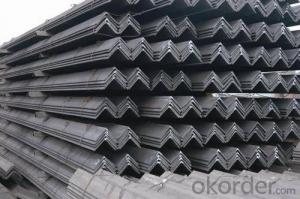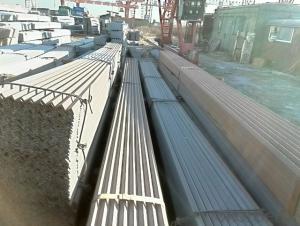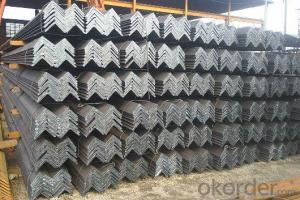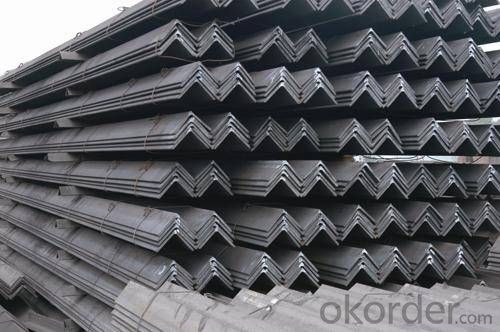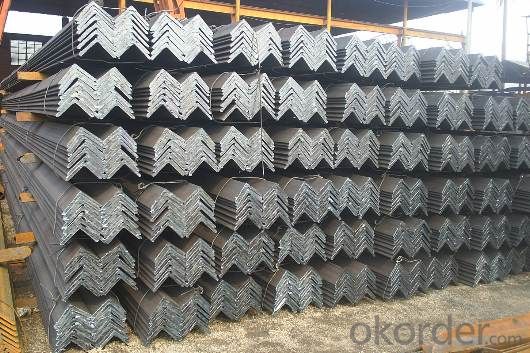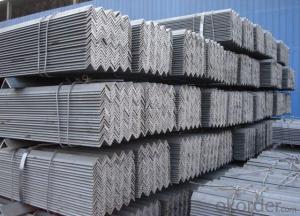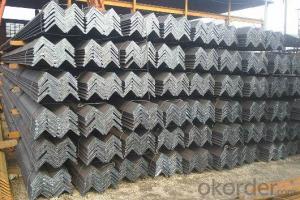Hot Rolled Steel Angles with High Quality
- Loading Port:
- Tianjin
- Payment Terms:
- TT OR LC
- Min Order Qty:
- 25 m.t.
- Supply Capability:
- 20000 m.t./month
OKorder Service Pledge
OKorder Financial Service
You Might Also Like
Product Description:
OKorder is offering high quality Steel Angle Bar at great prices with worldwide shipping. Our supplier is a world-class manufacturer of steel, with our products utilized the world over. OKorder annually supplies products to European, North American and Asian markets. We provide quotations within 24 hours of receiving an inquiry and guarantee competitive prices.
Product Applications:
Steel Angle Bars are ideal for structural applications and are widely used in the construction of buildings and bridges, and the manufacturing, petrochemical, and transportation industries.
Product Advantages:
OKorder's Steel Angle bars are durable, strong, and resist corrosion.
Main Product Features:
· Premium quality
· Prompt delivery & seaworthy packing (30 days after receiving deposit)
· Corrosion resistance
· Can be recycled and reused
· Mill test certification
· Professional Service
· Competitive pricing
Product Specifications:
Manufacture: Hot rolled
Grade: Q195 – 235
Certificates: ISO, SGS, BV, CIQ
Length: 6m – 12m, as per customer request
Packaging: Export packing, nude packing, bundled
Sizes: 25mm-250mm | ||
a*t | ||
25*2.5-4.0 | 70*6.0-9.0 | 130*9.0-15 |
30*2.5-6.6 | 75*6.0-9.0 | 140*10-14 |
36*3.0-5.0 | 80*5.0-10 | 150*10-20 |
38*2.3-6.0 | 90*7.0-10 | 160*10-16 |
40*3.0-5.0 | 100*6.0-12 | 175*12-15 |
45*4.0-6.0 | 110*8.0-10 | 180*12-18 |
50*4.0-6.0 | 120*6.0-15 | 200*14-25 |
60*4.0-8.0 | 125*8.0-14 | 250*25 |
FAQ:
Q1: Why buy Materials & Equipment from OKorder.com?
A1: All products offered byOKorder.com are carefully selected from China's most reliable manufacturing enterprises. Through its ISO certifications, OKorder.com adheres to the highest standards and a commitment to supply chain safety and customer satisfaction.
Q2: What makes stainless steel stainless?
A2: Stainless steel must contain at least 10.5 % chromium. It is this element that reacts with the oxygen in the air to form a complex chrome-oxide surface layer that is invisible but strong enough to prevent further oxygen from "staining" (rusting) the surface. Higher levels of chromium and the addition of other alloying elements such as nickel and molybdenum enhance this surface layer and improve the corrosion resistance of the stainless material.
Q3: Can stainless steel rust?
A3: Stainless does not "rust" as you think of regular steel rusting with a red oxide on the surface that flakes off. If you see red rust it is probably due to some iron particles that have contaminated the surface of the stainless steel and it is these iron particles that are rusting. Look at the source of the rusting and see if you can remove it from the surface.
Images:
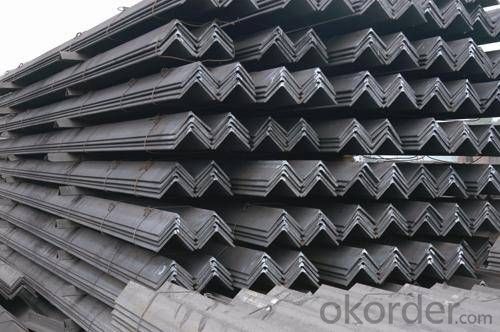
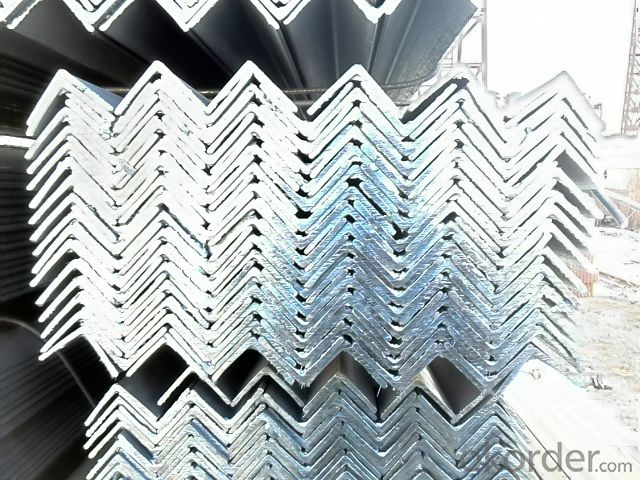

- Q: Are there any limitations on the length-to-thickness ratio of steel angles?
- Steel angles have limitations on their length-to-thickness ratio, which is also known as the slenderness ratio. This ratio is crucial in determining the structural stability and load-bearing capacity of steel angles. To calculate the slenderness ratio, divide the angle's length by its thickness. In general, steel angles with a higher length-to-thickness ratio are more prone to buckling or failure when subjected to compressive loads. To maintain structural integrity, there are industry standards and guidelines that define the maximum slenderness ratios for steel angles. The specific limitations on the length-to-thickness ratio of steel angles vary based on factors such as the steel type, angle cross-sectional shape, applied load, and intended use. These limitations are typically outlined in engineering codes and standards like the American Institute of Steel Construction (AISC) or Eurocode, which provide design guidelines for various structural components, including steel angles. Adhering to these limitations is crucial to prevent structural failures and ensure the safety and performance of steel angles in different applications. Structural engineers and designers should consult the relevant codes and standards to determine the appropriate length-to-thickness ratio for specific steel angle designs.
- Q: What is the typical corrosion rate of steel angles?
- The typical corrosion rate of steel angles can vary depending on various factors such as the environment, exposure to moisture, presence of corrosive substances, and maintenance practices. However, on average, steel angles can experience a corrosion rate of around 0.1 to 1.0 millimeters per year.
- Q: Can steel angles be used for bracing or reinforcement?
- Yes, steel angles can be used for bracing or reinforcement in various applications. They provide structural stability and support, commonly used in construction, engineering, and infrastructure projects. Steel angles offer strength and durability, making them suitable for reinforcing beams, columns, frames, and other structural elements.
- Q: What are the different methods for painting steel angles?
- There are several different methods for painting steel angles, depending on the desired result and the specific conditions of the project. Some common methods include: 1. Brush application: This is the most traditional and commonly used method for painting steel angles. It involves using a paintbrush to apply the paint directly onto the surface of the steel angle. This method allows for more control and precision in painting, especially for smaller or intricate areas. 2. Spray application: Spray painting is a popular method for large-scale or industrial projects. It involves using a paint sprayer to evenly distribute the paint onto the steel angle. This method is faster and more efficient than brush application, and it can provide a smooth, uniform finish. 3. Powder coating: Powder coating is a method that involves applying a dry powder to the steel angle, which is then cured under heat to create a durable and attractive finish. This method is known for its resistance to chipping, scratching, and fading, making it ideal for outdoor applications or areas with high traffic. 4. Electrostatic painting: Electrostatic painting is a technique that uses an electric charge to attract the paint particles to the steel angle. This method ensures even coverage and reduced overspray, resulting in a smooth and durable finish. Electrostatic painting is often used for large or complex surfaces, as it can provide superior adhesion and coverage. 5. Galvanizing: Galvanizing is a unique method for protecting steel angles from corrosion. It involves coating the steel angle with a layer of zinc through a hot-dip or electroplating process. Galvanized steel angles are highly durable and resistant to rust, making them suitable for outdoor or high-moisture environments. While galvanizing does not provide a specific color or aesthetic finish, the zinc coating can be painted over if desired. When selecting a painting method for steel angles, it is essential to consider factors such as the desired appearance, durability, environmental conditions, and project specifications. Consulting with a professional or following the manufacturer's recommendations can help ensure the best method is chosen for each unique project.
- Q: Are steel angles suitable for manufacturing structural beams?
- Yes, steel angles are suitable for manufacturing structural beams. Steel angles are versatile and commonly used in construction for their strength, durability, and ability to support heavy loads. They can be easily welded or bolted together to form beams of various lengths and sizes, making them a popular choice in structural engineering.
- Q: Can steel angles be used for framing windows?
- Yes, steel angles can be used for framing windows. They are commonly used in construction as a structural element for window frames due to their strength, durability, and ability to support heavy loads.
- Q: Are steel angles suitable for vehicle ramps?
- Yes, steel angles are suitable for vehicle ramps. Steel angles provide strength and stability, making them an ideal choice for supporting the weight of vehicles and ensuring safe and durable ramps.
- Q: Can steel angles be used as supports for mechanical or HVAC ducts?
- Yes, steel angles can be used as supports for mechanical or HVAC ducts. Steel angles are commonly used in construction and engineering as they provide structural support and stability. They are strong and durable, capable of withstanding heavy loads and maintaining their shape over time. When properly installed, steel angles can effectively support the weight of mechanical or HVAC ducts, ensuring that they stay in place and do not sag or collapse. Additionally, steel angles can be easily customized and adjusted to fit specific duct sizes and configurations. Overall, steel angles are a reliable and cost-effective solution for supporting mechanical or HVAC ducts.
- Q: How are steel angles measured and specified?
- Steel angles are typically measured and specified based on their dimensions and structural characteristics. The dimensions of a steel angle are determined by the length of its legs and the thickness of its material. The length of the legs refers to the vertical and horizontal sides of the angle, while the thickness represents the width of the angle. The dimensions of a steel angle are commonly expressed in two formats: the length of the legs followed by the thickness, or the thickness followed by the length of the legs. For instance, an angle with legs measuring 2 inches and a thickness of 1/4 inch can be specified as either 2" x 2" x 1/4" or 1/4" x 2" x 2". In addition to the dimensions, steel angles may also be specified by their structural characteristics. This includes the type of steel used, such as carbon steel or stainless steel, as well as the angle's load-bearing capacity and resistance to corrosion. Steel angles are widely used in construction, manufacturing, and various industrial applications. They are commonly used to provide structural support, as reinforcements, or as framing elements. By understanding how steel angles are measured and specified, architects, engineers, and builders can accurately select and utilize the appropriate angles for their projects.
- Q: Can steel angles be used in agricultural applications?
- Yes, steel angles can be used in agricultural applications. Steel angles are versatile and durable structural components that can be used in various agricultural applications such as constructing farm buildings, barns, sheds, and livestock enclosures. They provide strength and stability to the structures, making them suitable for withstanding the heavy loads and harsh weather conditions commonly found in agricultural environments. Additionally, steel angles can be easily welded or bolted together, allowing for flexibility and ease of construction. Their corrosion-resistant properties also make them ideal for outdoor agricultural applications where exposure to moisture and chemicals is common. Overall, steel angles are a reliable and cost-effective choice for agricultural construction needs.
Send your message to us
Hot Rolled Steel Angles with High Quality
- Loading Port:
- Tianjin
- Payment Terms:
- TT OR LC
- Min Order Qty:
- 25 m.t.
- Supply Capability:
- 20000 m.t./month
OKorder Service Pledge
OKorder Financial Service
Similar products
Hot products
Hot Searches
Related keywords
